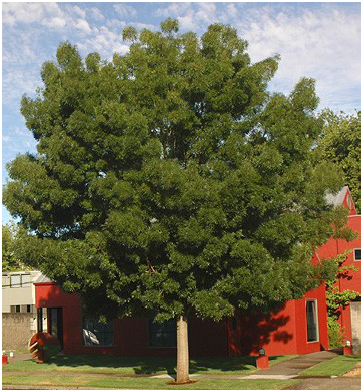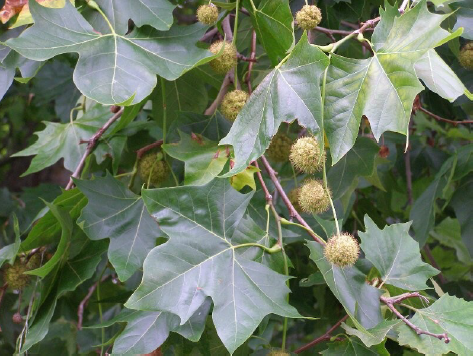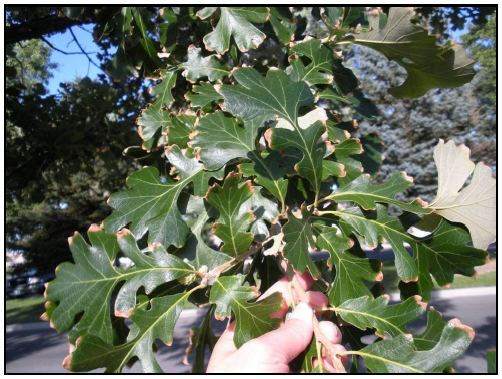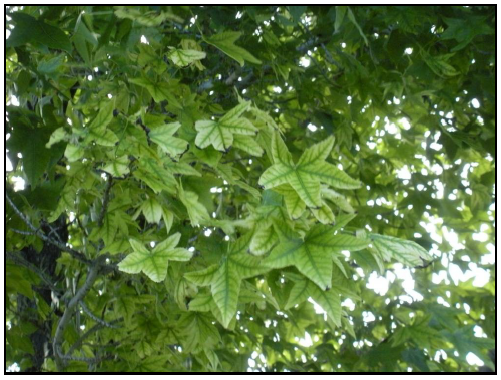What is boron?
Boron is a mineral that, in small quantities, is essential for plant growth and development, but becomes toxic at levels above 0.5 to 1 part per million (ppm) in the soil. Excess boron may be naturally present in the soil, and it can accumulate by irrigating with water high in boron. Boron occurs naturally in arid soils originating from geologically young deposits. It may accumulate in soils that are heavily amended with borate-containing fertilizers. In Nevada, well water or water from springs near geothermal areas or earthquake faults may contain high concentrations of boron. Excessive concentrations are rarely found in surface water. Boron can also enter the soil from sewage effluent or from irrigation with reclaimed water. Boron is mobile in soils, and will move up in the soil horizon as moisture evaporates and down when soils are irrigated with fresh water.


Boron and salty soils
Soils high in boron may also be salty. Soils become salty for some of the same reasons as they become high in boron. In cold climates, road salt may also contribute to the saltiness of landscape soils. Salty soils contain higher than normal levels of mineral salts, such as chlorides, sulfates, ammonium or even sodium. High levels of mineral salts in soils damage sensitive plants. Alone, these mineral elements are called specific ions, and plants can be sensitive to individual specific ions in addition to the overall soil salinity. Boron is a specific ion, but it is toxic at such low levels that it must be tested for separately from soil salinity. Only a few landscape plants are known to be tolerant of both high soil salt and the presence of high levels of boron (Table 1).
Symptoms of boron toxicity
Symptoms of boron toxicity occur on older leaves of plants, and look much like symptoms of high salinity, or of iron or manganese deficiencies. Early stages of boron toxicity show up as chlorosis (yellowing) of leaf tips, and are followed by necrosis (death) of leaf margins and of the tissues in between leaf veins. In particular, later stages of boron toxicity exhibit as blackened areas or irregularly shaped black spots along leaf margins or between leaf veins, depending on the plant species affected (page 4). Conifer needles die from the tip downward, with the most extensive damage occurring on older needles. It must be emphasized that nutrient deficiencies or specific ion toxicities cannot be accurately diagnosed by observing symptoms. Soil, water and/or tissue samples should be tested where a definitive diagnosis is required.
Managing plants in boron-laden soils
The most important step in managing high-boron landscape soils is proper plant selection. Do not install plants that are known to be sensitive to boron (Table 2). The boron tolerance of many landscape plants is unknown, and developers may encounter limitations in local availability of many boron-tolerant plant varieties due to their lack of cold-hardiness. The historical approach has been to irrigate these soils more frequently with fresh water to leach salts and boron below the plant root zone. However, some boron-infested areas have high water tables, high pH and/ or may have soils with poor structural characteristics, such as sodium-affected (sodic) soils, leading to insufficient drainage. These conditions exacerbate boron toxicity, and irrigating more frequently leads to overwatering. Another confounding factor is the presence of hardpan in the soil horizon, which also interferes with soil water drainage. A more recent approach to planting in boron-laden landscapes is to install plants above the native soil. This can be achieved by bringing in higher quality topsoil or other appropriate planting substrate and creating “planting mounds” for trees and shrubs. To be effective, mounds must be at least 12 inches in depth and extend beyond the drip line of landscape plants.
This practice lifts most of the plant feeder roots out of the boron-laden zone and improves aeration and drainage. It is most effective when plants are clustered in groups on a mounded island, rather than individually mounded in a linear design.
Will adding soil amendments help?
Gypsum (calcium sulfate) is often recommended to improve soil structure, change soil pH and/or leach salts from soils. Gypsum, used at the proper rate, will leach sodium ions from sodic soils. Sodic soils are high in exchangeable sodium relative to calcium and magnesium. High levels of sodium in soils leads to breakdown in soil structure and results in fine-textured soils that lack aeration or good water infiltration. The calcium in gypsum used to remedy such soils displaces sodium ions, which must be leached below plant root systems using good-quality water. However, the sodium must have some place to go, and leaching of sodic soils is ineffective in areas with drainage problems, such as floodplains or areas with hardpan layers in the soil horizon. Gypsum is required in large quantities, takes a long time to have an effect and the results are temporary. So leaching with gypsum must be repeated regularly, which is impractical in urban landscapes. Studies show that use of gypsum to lower soil sodium is most effective in agricultural areas, where regular disturbance of the soil is acceptable. Gypsum does not affect the level of other mineral salts, including boron, in soils. Gypsum can improve the structure of heavy clay soils, but does not improve water-holding capacity or fertility of sandy soils. Finally, gypsum does not significantly affect the soil pH.
Sulfur is often recommended for lowering the pH of alkaline soils. It is effective for use prior to landscape establishment, but it takes a long time (sometimes years) to have an effect on pH. It can cause damage to plants and increase soil salinity if used regularly on established landscapes. The pH of a soil refers to its acidity or alkalinity. Plants grow best at a pH between 5.5 and 7.5. Alkaline soils have a pH above 7.5, which causes some soil nutrients to become unavailable to plant roots. Obviously, lowering the pH of our soils will be beneficial to plant growth and health. Unfortunately, many of the soils in northern Nevada have a high level of “free lime” or calcium carbonate. This means that the soil is buffered and resists significant changes in pH. Adding sulfur to such soils is a costly waste of time and will not be effective. Elemental sulfur may be used in localized areas around plant roots to alleviate pH-related nutrient deficiencies, and it may also be used to leach sodium from sodic soils. It has no effect on soil structure or other mineral salts, including boron.
Organic matter is an easy, safe and effective amendment that improves the structure and water-holding capacity of sandy soils and, over time, loosens compacted or heavy clay soils. Organic mulches moderate soil temperatures around plant roots, reduce germination of weed seeds by blocking light and break down slowly, gradually lowering soil pH and providing nutrients for landscape plants. Organic mulches include aged bark or wood chips, pesticide- and disease-free grass clippings and decomposing leaf litter. You can rarely go wrong by adding organic matter to your soil, and it is safe to use in established landscapes. The only caveat is that homeowners and landscapers must use caution when applying organic mulches in fire-prone areas because most organic mulches are highly combustible. In these areas, use of organic mulch should be limited to the space within the drip line of trees and not connected to other mulched areas. Well-rotted animal manure is another effective organic amendment but its overuse may add to the saltiness of already salty soils. Finally, even organic matter will not significantly lower soil salts, including boron.
Symptoms of boron toxicity are species-dependent. These trees are growing in the same landscape but show varying symptoms depending on their tolerance for high soil salts, pH and boron.

Boron toxicity symptoms on bur oak present as browning at the tips of the foliage. Many oaks are intolerant of ex-cess boron in the soil.

Sweetgum is moderately tolerant of salty and boron-laden soils, but it is very sensitive to high pH. This tree has severe iron-deficiency chlorosis as a result of the high pH of the soil in this landscape.

The needles of blue spruce in boron-laden soils brown from the tip down. Older needles are affected first, and over time, the tree will lose more needles than it can replace.
Table 1. Boron- and Salt-Tolerant Tree and Shrub List
* May be planted only in unincorporated areas in Washoe County.
Table 1. Boron- and Salt-Tolerant Tree and Shrub List
Table 2. Trees and shrubs known to be sensitive to boron
Table 2. Trees and shrubs known to be sensitive to boron
Acknowledgments
Thanks to UNCE Master Gardener Carol Ort for compiling the list of plants for “Boron Sensitivity in Plants of Northern Nevada.” I thank Jana Vanderhaar, landscape architect with Verdant Connections, for her advice on tree and shrub selection for boron-infested areas. Also, thanks to Steve Churchillo, Reno city forester, for his advice on mound-planting for trees in boron-infested areas.
References
Carlos, B. 2000. Effects of Boron on Plants. University of Nevada Cooperative Extension.
Costello, L.R., E.J. Perry, N.P. Matheny, J.M. Henry and P.M. Geisel. 2003. Abiotic Disorders of Landscape Plants. University of California Agriculture and Natural Resources Publication 3420.
Donaldson, S. 1998. Boron/Plant Interactions. Report compiled for the Steamboat Creek Restoration Steering Committee.
Kratsch, H.A. 2011. Water-Efficient Landscaping in the Intermountain West. Utah State University Press, Logan, UT.
Kratsch, H., S. Olsen, L. Rupp, G. Cardon and R. Heflebower. 2008. Soil Salinity and Ornamental Plant Selection. Utah State University Extension Publication HG/Landscaping/2008-02pr.
Kuhns, M. 2009. TreeBrowser.org. Utah State University Extension. Accessed 6 November 2011.
Miller, W. W. 2011. personal communication. University of Nevada Reno.
Wu, L. and L. Dodge. 2005. Landscape Plant Salt Tolerance Selection Guide for Recycled Water Irrigation. A Special Report for the Elvenia J. Slosson Endowment Fund. University of California Agriculture and Natural Resources.


